|
Introduction
to SAC Patches |
|
Background |
| The
modern military patch is a means by which members identify themselves as
belonging to particular organization. The tradition extends back
to ancient times when armies adopted a coat of arms and specific colors to
identify themselves in battle.
|
The Strategic Air Command was officially
organized in 1946, but it's roots go back to the 1920's when General
Billy Mitchell developed the concept of strategic bombing. At that
time American bombers were under the command of the Army Air Corps and
traditional army officers, who saw the airplane as nothing more than
airborne artillery that could used to support ground battles. Such
tactical missions would later be assigned to fighters. General
Mitchell's strategic bombing concept advocated using large, long-range
bombers to destroy factories, transportation facilities and cities and
thus the ability and will of an enemy to wage war.
World War II saw the principal put into
practice, first against Germany, and then against Japan. During
this time, the basic combat unit was the Bombardment Group, consisting
of several Bombardment Squadrons. One or more groups were assigned
to a Wing that was generally a base headquarters and support
organization. Often the group and wing commanders were regular
army officers with no flying experience. |
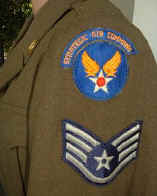 |
|
First
SAC Patch, circa 1947 |
|
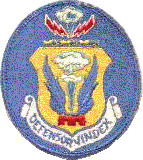 |
|
The 509th
Composite Group
was the beginning of SAC.
It dropped the A-bombs
on
Japan
|
|
When SAC was formed, it's basic combat unit was still the group.
During it's first year, nineteen groups were assigned to the command;
only four - the 28th, 43rd, 93rd and 509th remained active. Of
the four, only the 509th was fully manned and had experience with atomic
weapons. The other fifteen groups were inactivated. Over the
next few years, SAC expanded and new groups were formed. They were
given the same numeric designation as those that had distinguished
themselves in World War II, but they were new units and not a
continuation of the older groups. However, the Air Force wanted to
preserve it's history, so the new group was given the honors and awards
earned by it's predecessor of the same numeric designation.
During this time, the Air Force introduced a new organization,
one that put
combat commanders in charge of everything pertaining to the
accomplishment of their mission. The organization unit became the
Bombardment Wing. It contained a bomb group with two to four combat bomb
squadrons. Soon the group was phased out completely and the bomb
squadrons were assigned directly to the wing. A wing was also assigned it's own
maintenance squadrons and a combat support groups that ran the
base. For more information, see Wing
Organization. . |
|
Unit
Designations
|
Under the old army organization virtually every squadron had a different
numeric designation. This caused a great deal of confusion. Under the new wing organization,
all of the aircraft maintenance
squadrons carried the same number as the Wing. For example, the
380th Bombardment Wing maintenance units were the
380th OMS, the 380th FMS, the 380th A&E and the 380th MM. Only the
combat squadrons maintained a separate numeric identity as they were
often transferred from one wing to another. Over the years, the 380th had five combat units: the
528th, 529th, 530th
and 531st Bombardment Squadrons. It's
aerial refueling squadron was the 380th, but the same numeric
designation was strictly a coincidence, as such squadrons almost always
had a different number than that of the wing. Support groups had different
numbers. The
380th Bomb Wing operated out of Plattsburg Air Force Base, New York,
supported by the 820th Combat Support Group. All squadrons within
the group carried the same numeric designation - supply, engineering,
etc. The 820th Hospital Group
provided the medical facilities.
In 1947, SAC flew B-29s. Compared to
the B-17s and B-24s of World War II, they were big planes and their bomb
wings were designated "very heavy." Soon the enormous
B-36 entered SAC's inventory and this resulted in a reclassification of
both planes and bomb wings. The B-29 wings became "medium" and the
B-36 wings became "heavy." This designation was used by
the B-47 (medium) and B-52 (heavy) wings that followed. Some patches
carry such designations.
In the late 1950's, Soviet Missiles
posed an ever-increasing threat to SAC's bases. They traveled so
fast that SAC had only a few minutes to detect them and launch their
aircraft before being attacked. General Power introduced a
dispersal plan. B-52 wings then contained three squadrons of
fifteen planes. They were split into mini-wings, each containing
one squadron, and disbursed on three bases. These mini-wings were
called Strategic Wings. These newly-formed units were given four
digit numeric designations. The name of the unit from which they
were formed was changed from Bombardment Wing to Strategic Wing.
The same period saw the introduction of
missiles. The first units were squadrons and generally they were
assigned to a bomb wing. In such case, the name of the wing was
changed from Bombardment Wing to Strategic Aerospace Wing.
Plattsburgh AFB was soon ringed with a dozen Atlas Missiles, manned by
the 556th Strategic Missile Squadron and the
380th Bombardment Wing became the 380th Strategic Aerospace Wing.
The Minuteman missile was deployed in such large numbers that Strategic
Missile Wings were formed. As with the bomb wings, missile squadrons had different numbers than the
wing. |
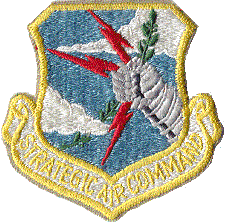 |
|
The
famous SAC Crest
was adopted July 4, 1961
|
|
During
the first few years of operations, the combat unit was the group and
some early SAC patches carry this designation. Generally they were
the same design as that used in World
War II. Wings were given a great deal of
freedom in designing their patches. Some were round, some were
rectangular and others were an early shield design, such as that for the
5th Bomb Wing shown below. On July 4, 1951, SAC officially adopted
it's new insignia - the armored first striking through the sky at
lighting speed to preserve the laurels of peace. The standard
shape for a wing insignia became the shield, representing SAC's
defensive role. The shield was also used for units higher in the
echelon, the air division and the numbered air force. Squadron
patches could be any shape.
In the 1950's and for most of the 1960's, SAC
bombers were shiny aluminum with the bottom painted white to reflect
heat from a nuclear blast. The Vietnam war brought combat and camouflage
paint schemes to help protect the planes from attack. Patches soon
became subdued. After
SAC's 1991 demise, the few surviving bomb wings were assigned to the new
Strategic Command. Freed of past restrictions and traditions, they
developed more modern designs, such as that of the 509th Bomb Wing shown
below. |
| Wing
Patches |
|
Below are some typical patches. The first is for the 5th Bomb
Group. The 380th Bomb Wing was formed in 1953 and it's patch is a
shield. For the first few years, the motto scroll read,
"380th Bombardment Wing (medium), but was later replaced with the
wing motto "Strength and Confidence," which is shown
below. Around 1968, it began using the subdued
patch. The new 509th patch shows the stealth
bomber. The shield has been abandoned. Compare the 509th patch
below with the 509th group patch at top of this page. |
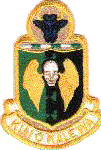 |
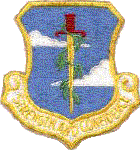 |
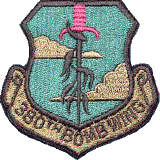 |
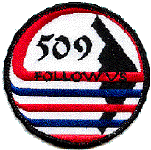 |
| 5th
BG - 1947 |
380th
BW - 1959 |
380th
BW - 1968 |
509th
BW - 2000 |
| Most bombardment, aerial refueling squadrons,
aircraft maintenance and missile squadrons adopted round patches, but
many other shapes
were also used. |
| Aircraft
Maintenance Squadron Patches |
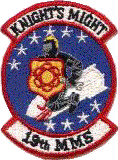 |
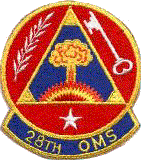 |
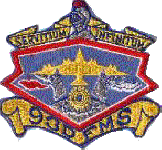 |
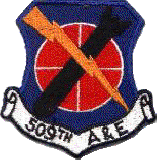 |
| 19th MM |
28th OMS |
93rd FMS |
509th
A&E |
| Patch
Acquisition |
|
Most Airmen acquired their patches from the Base Exchange. It
usually had on hand SAC, Wing and Combat Support Group
patches. There were far fewer airmen assigned to the Squadrons, so
there was much less demand for their patches. Often, they were not
available. Many squadrons had them made. Custom patches were
also acquired for specific missions and
exercises.
Air Divisions were first assigned to
bases that had two or more groups or wings. Later the units were
disbursed, but the air division remained. These only had 18 people
assigned to them. There were only a very few patches made and they
are very rare. |
| Patch
Usage |
The army
and marines maintain very rigid uniform standards, probably because it's
men were often in formation and needed to look "uniform." This was
not the case in SAC. It's men were highly skilled and SAC demanded
a lot from them. Formations were rare. To somewhat offset
the many demands SAC made on it's men, it did not burden them with
traditional military dress standards. (also known as "B.S.")
Combat and flight line personal were given a great deal of freedom in
the design of their uniforms, their choice of patches, and where they
were positioned.
The first consideration was availability. Many patches
were difficult to obtain. Another was rank and the nature of the
uniform. Air force stripes consist of wings that flare upward.
Those for high-ranking sergeants take up a lot of sleeve space, leaving
virtually no room for a shoulder patch. When wearing fatigues, airmen
usually wore their patches above one or both chest pockets.
Stripes were not usually put on flight jackets, so a patch was often put
on the shoulder.
Flight crews and missile crews usually wore their
squadron patch. Some would wear a second patch. Sometimes it
would be their wing, but more often it would be a SAC patch, as they
took great pride in their outfit. Aircraft maintenance personal
usually wore one patch. It could be that of their squadron, their
wing, or the SAC patch. They often could not get squadron patches,
so they usually wore the wing patch. Support Group personnel were
supposed to wear that of the group, but it had very few personal and
they often wore the SAC patch. Some groups had squadrons that had
their own patches, such as base operations, fire department,
supply and engineering. |
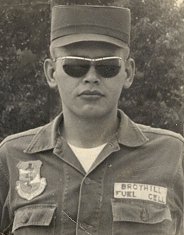 |
| Typical
flight line usage of patch at Plattsburg AFB in 1963. The
author (above) was in the 380th FMS. Squadron patches were
rarely available, so most men wore the 380th Bomb Wing patch.
|
|
|
